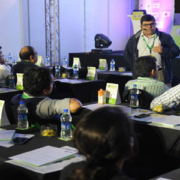Ankur Shiv Bhandari addressed Food and Grocery Forum India 2014 at Mumbai on ‘How to Influence Purchase Decisions of Shoppers’
Why should one care about shopper insights and how can a company influence shopper’s purchase decisions? Addressing the questions, a Master Class on “How To Maximize Sales Per Customer —Increasing the Shopping Basket Size of Each Customer Through In-Store Conversion Techniques,” was conducted by Ankur Shiv Bhandari, MD, Kantar Retail India & MD, ASBICON in the recently concluded Food & Grocery Forum 2014 at Mumbal.
Sharing the “PITA” model with the participants, which has been actively used to define shopper centric behaviour, Bhandari said PITA stands for Population, Incidence, Transactions, and Amount. He shared an insightful example on how number of baskets can be drilled down to Amount that brand has been able to generate out of the baskets. Bhandari further discussed the strategy of an FMCG MNC to increase the amount by increasing the size of product “Upsizing”.
The audience also pitched in with their experiences on below the line and above the line customer purchase behaviour and how companies are able to influence consumer behaviour. Bhandari then spoke about two categories of shoppers, i.e., Category Acceptors and Category Rejecters. He further divided Category Acceptors into Brand Loyalists, Switchers, and Rejecters. Bhandari said “BOGO is for rewarding loyal customers and taking them out of the market for a specific period.” He gave interesting example of UK retailers accepting each other’s shopping coupons to acquire customer as part of promoting brand switching.
“Why do customers shop?” was the next question discussed at the Master Class. Bhandari mentioned that it is important to understand what are the shopping occasions which drive shoppers to shop. Quoting an example, he said that the penetration of juices and nectar is minimal in India where only two percent of the shopping population purchases juice. This data pertains to the country level which includes both rural and urban and organised and unorganised retailing. However, for the West, the figure stands at 70 percent indicating a huge opportunity in the Indian market.
He also mentioned about a study done on the juice and nectar business by a leading Indian brand to increase the penetration. The project went through various phases and analysed the shoppers’ data in qualitative and quantitative way, classified the data, and came up with shopper missions e.g easy to shop, breakfast, lunch etc.
It was highlighted that shoppers consider fIavour over the brand. In the 10 pilot stores, the juices were arranged by flavours first then the brand and then the whole category focus was brought in e.g Juices for Joy. Results showed 15 percent increase in the juices sale in the 10 pilot stores.
The Master CIass then held a discussion on “How much can a company influence shopper’s purchase decisions?”
Sharing his insights on the same, Bhandari said that there is a cycle of purchase and each element in the cycle can be influenced. Post Shopping & Pre-Shopping, the cycle involves evaluation, attitude, preparation, shopping pattern, decision making, and consumption.
He further added that it is the “portfolio strategy” which is important to influence the behaviour at the store level. Speaking about the “OBPPC Principles,” Bhandari pointed out that each pack has a distinct role to play and the right pack size is important, different pack sizes uniquely captures a shopper’s need, and offering is differentiated across channel.
Bhandari cited an example of 5 percent overall category explanation by Coke which created PET bottles in right sizes that is 1.25 L, 2.0 L and 2.5 L and clearly defined role for each pack size. However, sometimes it becomes difficult to convince the retailer to stock packs of different sizes e.g. 200 ML at Big Bazar despite huge need in the category (Just in Time consumption, School Children, Served Chilled). Giving another example, he also spoke about a UK retail giant in gifts retail where they used emotive
signal for shoppers to switch from functional to emotion-driven shopping. Bhandari also urged to focus on category growth drivers for increasing the loyalty among consumers, for example, bigger packing formats and displaying nutritional information. He concluded by saying that category growth can happen through insight-driven activators to meet the needs of the shoppers and laying emphasis on “Engage, Entice and Convert.”

